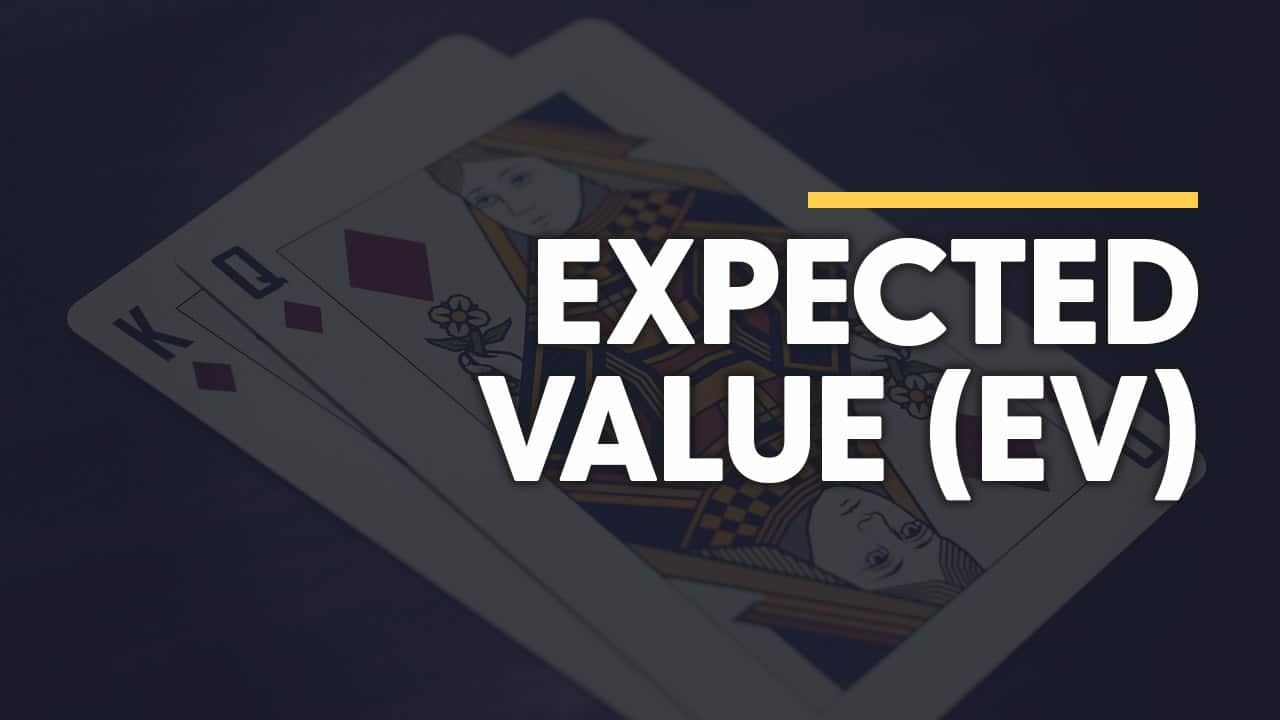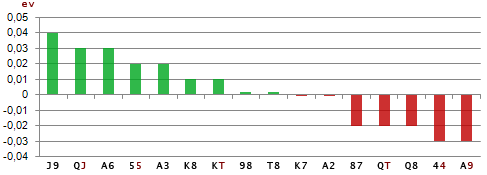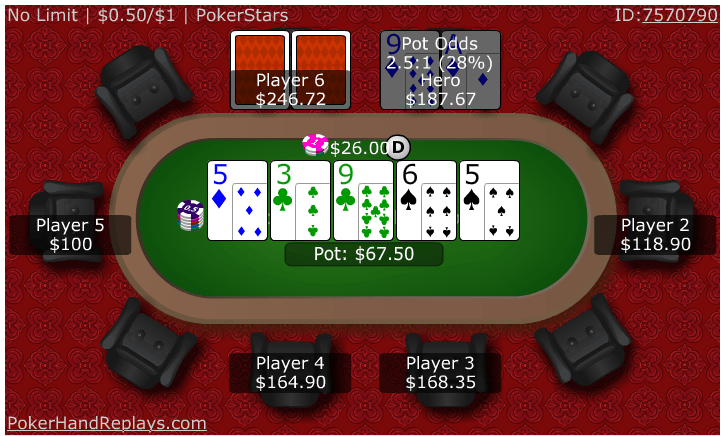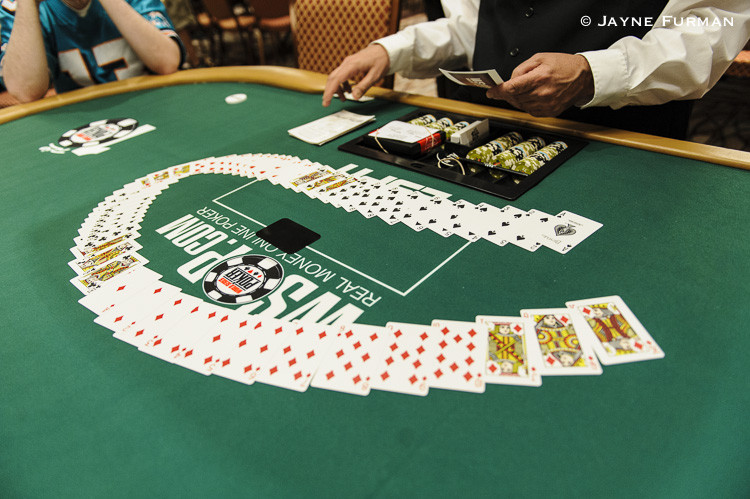Poker Expected Value Starting Hands
NL Hold’em Starting Hand Charts
Starting hand guide for no limit holdem 6 max games. This chart is for beginning players and advocates a really tight-aggressive (TAG) preflop starting hand strategy. With some experience you can broaden your preflop starting hand range, also your 3betting and 4betting range. Poker EV (expected value) EV (expected value) is one of the most important aspects in all sorts of gambling. EV in poker can be measured in many ways - some ways less exact than others. One important area in poker that varies from positive to negative EV is the starting hands.
EV, short for expected value, is the most vital mathematical concept in poker. When we say that something is +EV it means the play is expected to be profitable in the longrun. Whereas a play that is -EV is expected to lose us money in the longrun. The Poker EV Formula. The most simple poker expected value (EV) formula is this. Expected Value in Texas Holdem. An important concept that most winning Texas holdem players understand is expected value. The expected value is the average amount you win or lose on a situation if you were able to play the exact same situation thousands of times. It can be difficult to understand expected value on a hand. Your EV (expected value) is. The basic formula is simple: EV = (W%.$W) – (L%.$L) Put another way, multiply what a win is worth by how often you expect to win and the subtract the multiple of what a loss costs you and how often you expect to lose. And of course, W%+L% = 100%.
One aspect of the game of No-Limit Hold’em that causes beginning players much grief is deciding which hands to play and which hands to dump. NL Hold’em is much more difficult than Limit Hold’em because the value of a hand depends on so many factors other than just the cards in your hand. Despite this difficulty, our coaches believe that following some general guidelines and adjusting from these is a better solution than having no guidelines at all. Given that well over half of your profitability in NL Hold’em is based on hand selection alone, we have developed these charts to help you better determine whether to play or fold.
There are no perfect No-Limit starting hand charts. That is because there are many factors that affect your decision, and charts cannot account for all of them. Some of these include:
- The size of your opponent's stacks.
- How loose or tight, passive or aggressive, your opponents are.
- Where these opponents are located at the table – for example, does an aggressive player still have to act after you?
- Your image at the table – for example, how tight or tricky you are perceived.
That being said, these charts will serve you well in most typical low-stakes No-Limit cash games, such as games with blinds of $1/$2, and home games. These games typically have several loose players at the table, and good opportunities for winning big pots with suited connectors and pocket pairs. With practice, you will be able to be a consistently winning player with these charts as a starting point. As you improve, you'll find yourself making adjustments to these charts based on the factors listed above, and more.

AGAIN: These charts are a good starting point for beginners. Specifically, Chart #1 recommends a significant amount of limping. This is great in loose, passive games but less often seen in tougher games. You’ll find other training material on Advanced Poker Training that may recommend a more aggressive approach for more experienced players.
Note: It would be a serious mistake to apply these hand charts before reading the Frequent Asked Questions first.
CHART #1 ‐ LOOSE, PASSIVE GAME (OFTEN 4-5 LIMPERS PER HAND)
NO ONE HAS RAISED YET
- Raise Always
- Call from Early Position, otherwise raise
- Call always
- Call from Middle or Late Position if the conditions are right (see Frequently Asked Questions)
CHART #2 ‐ TIGHTER GAME (FEWER LIMPERS) OR MORE AGGRESSIVE GAME
NO ONE HAS RAISED YET
- Raise Always
- Call from Early Position, otherwise raise
- Call (or Raise) from Middle or Late Position if the conditions are right (see Frequently Asked Questions)
CHART #3 ‐ THERE HAS BEEN A SINGLE RAISE
(3‐5 TIMES THE BIG BLIND) BEFORE YOU

- Re‐Raise Always
- Call from Early Position, otherwise re‐raise
- Call always
- Call from Middle or Late Position if the conditions are right (see Frequently Asked Questions)
FREQUENTLY ASKED QUESTIONS
For the hands in yellow, what do you mean when you say to play these hands if the conditions are right? The hands in yellow are speculative hands. They should always be folded from Early Position. From other positions, they can be profitable given the right conditions. Some of the questions to ask yourself:
- Are there other players who have called so far (the more, the better)?
- Are the players who have called playing poorly after the flop? Will they pay me off if I hit something?
- Is there an aggressive player still to act behind me (you might get raised and have to fold)?
- If there has been a raise and no other callers, what chance do I have of using my position after the flop to win the hand even if I don't improve (Chart #3 only)?
Why does Chart #2 say to sometimes raise with the hands in yellow, but Chart #1 does not? We have different goals in mind. Using Chart #1, we want to call to encourage additional players to enter the pot. These hands will be immensely profitable when our loose, passive opponents enter the hand, and get trapped when we flop a set, or make a well-disguised straight. When using Chart #2, however, we want to size up the opponents still to act. If they are tight, we can raise. Sometimes, we'll pick up the blinds. Other times, our pre-flop aggression will allow us to take down the pot on the flop.
What's the difference between AKs and AKo? AKs means an Ace and King of the same suit. AKo means an Ace and King of different suits.
What are early, middle, and late position? Early Position is generally the first 2 (in a nine player game) or 3 (in a ten player game) positions after the blinds. Late Position is the “cutoff” position (to the right of the dealer), and dealer button positions. Middle Position is everything in between.
How much should I raise? As a general rule, raise 3 to 4 times the big blind, plus 1 extra big blind for every player who has called before you. So if there are 2 callers already, raise between 5 and 6 times the big blind.
What if someone raises after I call? Whether you call the raise depends on how much money the raiser has for you to win, how many other players are involved, and what type of hand you have. As a general rule, if you have a pocket pair, lean towards calling. If there are a lot of other players (and therefore a big pot), lean towards calling. In general, fold suited connectors from early position. Fold hands like KQ that don't play well against a raiser.
How do I play from the blinds? From the small blind, play the same hands you would play from late position, plus a few more. But don't call with junk hands like T5o, just because it is “cheap”. From the big blind, if there is a raise to you, play like you would if you had already called from early position.
The chart says to fold KQo to a raise. Really? Yes, this hand performs very poorly against typical raising hands. Against AK, AQ, AA, KK, QQ, you are a big underdog. Other typical raising hands like JJ, TT, 99, AJs, are slightly ahead of you as well. The only time you might call or re-raise is from late position, if the opener was in middle or late position, indicating they might have a wider range of hands.
I was told to fold AJo from Early Position, why do you say to call with it? Folding AJo is not a bad idea in many games. We included it because, at low stakes tables (even tight or aggressive ones), the players are often playing badly enough after the flop that it can be profitable. We used data from millions of hands of low-limit poker to analyze this. The same could be said for KQo, ATs, and KJs – you can make a small profit in the long run at most low-stakes games, but folding would be perfectly acceptable from early position.
Expected Value Holdem Hands
Can I use these charts in a NL Hold'em tournament? The charts would be best applicable to the early stages of a NL tournament, when everyone has a deep stack. In the middle and later stages, they should not be used.
Poker Expected Value Starting Hands N
Read all our instructional articles
Poker Hand Values Chart
Expected Value (EV) is the average return on each dollar invested into a pot. If a player can expect, given probability to make more money than he or she bets, the action is said to have a positive expectation (+EV). Conversely if a bet or a call will, according to probability, likely result in less money being returned the action is said to be negative (-EV).
An example may assist in the understanding of this concept. In Texas Holdem it is quite common for someone to flop 4 to a flush. The person should only draw to that flush if to do so would be +EV. In order to calculate the EV it is necessary to compare the size of the bet with the size of the pot. A flopped flush draw will come in approximately 1 in 3 times by the river, thus in order for a call to be +EV the final pot must be larger than 3 times the call. This is a complicated issue so it may be useful to elaborate with a specific example.
Say you are playing 5-10 limit poker on the button, there are 3 limpers to you and you call with A4 diamonds. Both Blinds call so there is $30 in the pot. You flop the nut flush draw. The player in the small Blind bets $5 and there are four callers. Should you call, raise or fold?
Well, there is now $55 in the pot and it will cost you $5 to call so the pot is giving you 11:1 odds (i.e. you must pay $5 to win $55). We already know that the flush draw will get there 1 time in every 3 (2 to 1) so making the call is +EV. However, calling is not necessarily the best play in this situation. If you raise and the other 5 people in the pot decide to call your raise then you will be adding $5 to the pot whilst they will collectively be adding $25. This ratio is 5:1 but the chance of making your flush is only 2 losses to 1 win, so on average in the long run you are making money from every extra bet from all 6 of you that goes into the pot. Notice that even though you have only a 33% chance to win the pot, the correct thing to do is actually to bet, despite knowing that you will probably not win that particular single hand: you will win about 1 in 3 such hands in the long run, minus the few percent of the time when someone beats your flush with a full house or quads or straight flush.
Notice that all that has been done so far is compare the current pot with the bet size needed to call to calculate EV. However it is important to also compare the expected pot size by the end of the hand with the current bet. For example say you are playing no limit holdem and have a gutshot straight draw (giving you 4 outs to complete - approximately 1:12 against). If the pot is $30 and you are faced with a $10 bet the pot is not giving you the correct odds to call (it would need to be $120 total, plus your $10 call). However you also need to take into account the amount of money you may be able to extract from your opponents if you make your hand. If you expect your opponent to call a $100 bet if you make your hand, then the pot is really offering you 13:1 odds (the $30 pot at the time plus the $100 added on later streets) Therefore in this situation the +EV play would be to call. Thus when making decisions about whether to call a bet it is crucial to take into account both the stack sizes of yourself and your opponents and how willing they are likely to be to call big bets if you make your hand.
To make it easier to understand why this move is correct even though it usually loses, suppose you have a six-sided die. If you correctly guess what side it lands on, you will win $50. If you are wrong, you lose $5. You will be wrong five times out of six, but you stand to gain a lot over the long run! This is because the probability of guessing correctly is 1/6, sometimes expressed as odds, '5:1 against' (five losing possibilities, one winning possibility). However, the payoff odds are 50:5 ($50 won for a $5 bet), which can be reduced to 10:1, and 10:1 is twice as large as 5:1. The payoff odds are called pot odds in a poker game. Comparing the odds of winning to the pot odds is how you can estimate your expected value.



Ideally, you want to avoid all situations where you have a negative expectation. Even slightly negative situations can pile up and bleed away your bankroll. Casinos worldwide make MILLIONS of dollars lost by players against a 0.6% craps dice game house edge: even 0.1% is enough of an edge to wipe out all the billions of dollars of the richest man on earth, over time in the long run, which is why Bill Gates wisely bets only $5/hand for fun at blackjack!
Calculating expected value[edit]
You cannot always get a good idea of the chances of winning your hand & calculate the pot odds: at least, not without knowing what your opponents have, and they're not going to tell you! However, you will often have a draw which, if you hit, you will very likely win the pot. The exact arithmetic involved varies from game to game. In Texas hold'em and Omaha, once you see the flop, the percent chance of making your hand within one card is generally your number of outs (cards that will make your hand) multiplied by two, and the odds of making your hand within two cards is your number of outs multiplied by four. For example, if you have four hearts and you need one more for a flush, you have nine outs, because there are thirteen hearts in the deck, and subtracting the four hearts you already have gives nine. 9 × 2 is 18, so you have about an 18% chance of making the hand in the next card, and 9 × 4 is 36, so you have about a 36% chance of making it in two cards.
To make this easy, you want to turn this percent chance into odds, like 5:1 against. Fortunately, they are easy enough to memorize:
The odds in bold are the most important to commit to memory; the others can be easily estimated.
Now, take the x in the x:1 figure and multiply it by the bet size. For example, if the odds of making your hand are roughly 4:1, and the next bet costs $5, multiply 5 × 4 = 20. That means you want there to be at least $20 in the pot (be sure to include bets that have not been added to the pot proper yet!), preferably a bit more just in case unless you're certain to win if you hit your draw. If there is not at least $20 in the pot you will lay down your hand, unless you can check instead. If the table is really loose, and a lot of players are in the hand and are likely to stay in, and the pot will get really big, you may even want to raise. Normally, however, checking or calling is the correct move.
Notice we did not calculate the exact expected value. This is not necessary or indeed practical for most people. If it is negative, you get out, and if it is positive, you call. If you're a favorite to win the pot, you raise. However, as has been shown you can usually figure out if the value is only barely positive, for instance, the size of the pot is a dollar more than the odds of making your hand (and this dollar is small in proportion to the pot size). When faced with this situation, you might want to lay down your hand sometimes: you may be losing just a little money in the long run, but you keep your bankroll from taking big swings. But if you don't mind taking a gamble, by all means go for it!